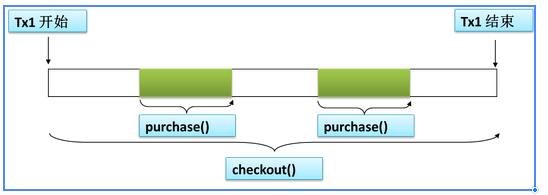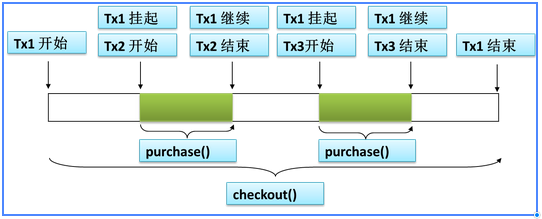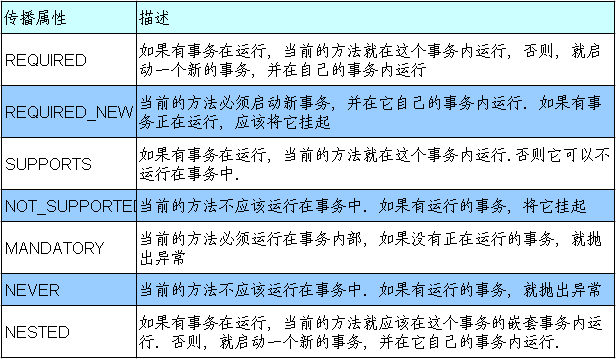Spring(四)-- JdbcTemplate、聲明式事務
阿新 • • 發佈:2017-08-31
子類 xmla 文件中 epo style 如果 2.2.0 not 可變參 1.Spring提供的一個操作數據庫的技術JdbcTemplate,是對Jdbc的封裝。語法風格非常接近DBUtils。
JdbcTemplate可以直接操作數據庫,加快效率,而且學這個JdbcTemplate也是為聲明式事務做準備,畢竟要對數據庫中的數據進行操縱!
JdbcTemplate中並沒有提供一級緩存,以及類與類之間的關聯關系!就像是spring提供的一個DBUtils。
Spring對數據庫的操作使用JdbcTemplate來封裝JDBC,結合Spring的註入特性可以很方便的實現對數據庫的訪問操作。使用JdbcTemplate可以像JDBC一樣來編寫數據庫的操作代碼
聲明式事務: 1.導jar包: - com.springsource.net.sf.cglib-2.2.0.jar - com.springsource.org.aopalliance-1.0.0.jar - com.springsource.org.aspectj.weaver-1.6.8.RELEASE.jar - commons-logging-1.1.3.jar - spring-aop-4.0.0.RELEASE.jar - spring-aspects-4.0.0.RELEASE.jar - spring-beans-4.0.0.RELEASE.jar - spring-context-4.0.0.RELEASE.jar - spring-core-4.0.0.RELEASE.jar - spring-expression-4.0.0.RELEASE.jar - spring-jdbc-4.0.0.RELEASE.jar - spring-orm-4.0.0.RELEASE.jar - spring-tx-4.0.0.RELEASE.jar - c3p0-0.9.1.2.jar - mysql-connector-java-5.1.37-bin.jar 2.創建一份jdbc.properties文件 : jdbc.user=root jdbc.passowrd=123456 jdbc.url=jdbc:mysql://localhost:3306/tx jdbc.driver=com.mysql.jdbc.Driver 3.配置文件,在 JdbcTemplate的配置信息的基礎上
事務的設置 - 事務的傳播行為
- 事務的隔離級別
- 事務根據什麽異常不進行回滾
- 事務的超時屬性
- 事務的只讀屬性 事務的傳播行為: -----propagation - REQUIRED :【默認】 如果外層有事務,就會調用外層的事務 如果外層沒事務,就自己啟動個事務,在自己的事務中運行 當第二個發生異常,第一個也跟著回滾


事務的隔離級別: ----- isolation 比如,當前數據庫中的price 為100,輸出100; 然後將 price 改為 200,再輸出還會是100,默認是REPEATABLE_READ,保持事務數據一致性 改為:READ_COMMITTED,就會隨著數據庫中的數據的更改,輸出也更改
<!-- 加載properties文件中 信息 -->
<context:property-placeholder location="classpath:jdbc.properties"/>
<!-- 配置數據源 -->
<bean id="comboPooledDataSource" class="com.mchange.v2.c3p0.ComboPooledDataSource">
<property name="user" value="${jdbc.username}"></property>
<property name="password" value="${jdbc.password}"></property>
<property name="driverClass" value="${jdbc.driver}"></property>
<property name="jdbcUrl" value="${jdbc.url}"></property>
</bean>
其中,新建 jdbc.properties 文件
內容:
jdbc.username=root jdbc.password=123456 jdbc.driver=com.mysql.jdbc.Driver jdbc.url=jdbc:mysql://localhost:3306/jdbc_template
③在IOC容器中配置JdbcTemplate對象的bean,並將數據源對象裝配到JdbcTemplate對象中
<!-- 配置JdbcTemplate對應的bean, 並裝配dataSource數據源屬性-->
<bean id="jdbcTemplate" class="org.springframework.jdbc.core.JdbcTemplate">
<property name="dataSource" ref="comboPooledDataSource"></property>
</bean>
實驗1:測試數據源
@Test
public void test() throws SQLException{
ApplicationContext ioc = new ClassPathXmlApplicationContext("applicationContext.xml");
DataSource bean = ioc.getBean(DataSource.class);
System.out.println(bean.getConnection());
}

實驗2:將emp_id=5的記錄的salary字段更新為1300.00【更新操作】
不用我們自己再去獲取數據庫連接信息了,而是直接傳遞sql語句及其參數!public class TestJDBCTemplate {
private ApplicationContext ioc = new ClassPathXmlApplicationContext("applicationContext.xml");
private JdbcTemplate bean = ioc.getBean(JdbcTemplate.class);
@Test
public void test() throws SQLException{
String sql = "UPDATE employee SET salary = ? WHERE emp_id = ?";
bean.update(sql, 1300,5);//第一個是sql語句,後面的按著順序傳入參數即可,這個update方法是接收的可變參數!
}
}
實驗3:批量插入 bean.batchUpdate(sql, list);
public class TestJDBCTemplate {
private ApplicationContext ioc = new ClassPathXmlApplicationContext("applicationContext.xml");
private JdbcTemplate bean = ioc.getBean(JdbcTemplate.class);
@Test
public void test() throws SQLException{
String sql="INSERT INTO employee(emp_name,salary) VALUES(?,?)";
List<Object[]> list = new ArrayList<Object[]>();
list.add(new Object[]{"Tom2015",1000});
list.add(new Object[]{"Tom2016",2000});
list.add(new Object[]{"Tom2017",3000});
bean.batchUpdate(sql, list);
}
}
實驗4:查詢emp_id=5的數據庫記錄,封裝為一個Java對象返回 分析:封裝為一個對象返回的話,首先我們需要有一個與數據表對應的實體類!
public class TestJDBCTemplate {
private ApplicationContext ioc = new ClassPathXmlApplicationContext("applicationContext.xml");
private JdbcTemplate bean = ioc.getBean(JdbcTemplate.class);
@Test
public void test(){
//需要註意的是:sql語句中的別名要與對應實體類的屬性名保持一致!
String sql = "SELECT emp_id AS empId,emp_name AS empName,salary FROM employee WHERE emp_id=?";
//RowMapper是一個接口,這裏我們使用其子類
RowMapper<Employee> rowMapper = new BeanPropertyRowMapper<Employee>(Employee.class);
//最後一個參數是可變參數,用於向sql語句中依次傳遞參數!
Employee employee = bean.queryForObject(sql, rowMapper, 5);
System.out.println(employee);
}
}
實驗5:查詢salary>4000的數據庫記錄,封裝為List集合返回
可以看出,查詢結果是一個實體還是一個list列表是靠bean對象的不同方法實現的!public class TestJDBCTemplate {
private ApplicationContext ioc = new ClassPathXmlApplicationContext("applicationContext.xml");
private JdbcTemplate bean = ioc.getBean(JdbcTemplate.class);
@Test
public void test(){
//需要註意的是:sql語句中的別名要與對應實體類的屬性名保持一致!
String sql = "SELECT emp_id AS empId,emp_name AS empName,salary FROM employee WHERE salary > ?";
//RowMapper是一個接口,這裏我們使用其子類
RowMapper<Employee> rowMapper = new BeanPropertyRowMapper<Employee>(Employee.class);
//該query方法查詢出來的是一個list列表,query方法的最後一個參數是可變參數!
List<Employee> list = bean.query(sql, rowMapper, 4000);
for (Employee employee : list) {
System.out.println(employee);
}
}
}
實驗6:查詢最大salary
public class TestJDBCTemplate {
private ApplicationContext ioc = new ClassPathXmlApplicationContext("applicationContext.xml");
private JdbcTemplate bean = ioc.getBean(JdbcTemplate.class);
@Test
public void test01(){
String sql = "SELECT MAX(salary) FROM employee";
//需要指定返回值的類型,而且類型必須是包裝類型
Double maxSalary = bean.queryForObject(sql, Double.class);
System.out.println(maxSalary);
}
}
實驗7:使用帶有具名參數的SQL語句插入一條員工記錄,並以Map形式傳入參數值
具名參數:是指基於名稱的,前面我們使用的都是用 ? 作為占位符,是基於位置的! 如果要使用具名參數的sql語句就必須在spring配置文件中配置NamedParameterJdbcTemplat這個模板類 原來的JdbcTemplate,因為JdbcTemplate不能完成這樣的任務! 在 applicationContext.xml 文件中繼續配置<!-- 為了執行帶有具名參數的SQL語句,需要配置NamedParameterJdbcTemplate -->
<!-- 該NamedParameterJdbcTemplate類沒有無參構造器,需要傳入JdbcTemplate對象或者數據源對象[DataSource] -->
<bean id="namedParameterJdbcTemplate" class="org.springframework.jdbc.core.namedparam.NamedParameterJdbcTemplate">
<!-- 不能使用property標簽配置 -->
<constructor-arg ref="jdbcTemplate"></constructor-arg>
</bean>
public class TestJDBCTemplate {
private ApplicationContext ioc = new ClassPathXmlApplicationContext("applicationContext.xml");
@Test
public void test01(){
NamedParameterJdbcTemplate bean2 = ioc.getBean(NamedParameterJdbcTemplate.class);
String sql="INSERT INTO employee(emp_name,salary) VALUES(:paramName,:paramSalary)";//具名參數與map 的key 值相同
Map<String,Object> paramMap = new HashMap<String,Object>();
paramMap.put("paramName","張學友" );
paramMap.put("paramSalary",1000);
bean2.update(sql, paramMap);
}
}
實驗8:重復實驗7,以SqlParameterSource形式傳入參數值
public class TestJDBCTemplate {
private ApplicationContext ioc = new ClassPathXmlApplicationContext("applicationContext.xml");
@Test
public void test01(){
NamedParameterJdbcTemplate bean2 = ioc.getBean(NamedParameterJdbcTemplate.class);
String sql="INSERT INTO employee(emp_name,salary) VALUES(:empName,:salary)";
//該BeanPropertySqlParameterSource類構造器需要一個對象參數,該對象參數是一個封裝了sql語句參數的對象!
//此時要求對象的屬性名要和sql中的參數名保持一致!這裏我們使用Employee對象來完成
Employee employee= new Employee("郭富城", 1500);
//以實體對象的形式封裝具名參數和值
SqlParameterSource source = new BeanPropertySqlParameterSource(employee);
bean2.update(sql, source);
}
}
實驗9:創建JdbcTemplateDao,自動裝配JdbcTemplate對象 1.創建dao類:
@Repository
public class JdbcTemplateDao {
@Autowired
private JdbcTemplate jdbcTemplate;
public void update(){
String sql = "DELETE FROM employee where emp_id = ?";
jdbcTemplate.update(sql, 15);
}
}
2.測試該dao
public class TestJDBCTemplate {
private ApplicationContext ioc = new ClassPathXmlApplicationContext("applicationContext.xml");
private JdbcTemplate bean = ioc.getBean(JdbcTemplate.class);
private JdbcTemplateDao dao = ioc.getBean(JdbcTemplateDao.class);
@Test
public void testEmployeeDao(){
dao.update();
}
}
聲明式事務: 1.導jar包: - com.springsource.net.sf.cglib-2.2.0.jar - com.springsource.org.aopalliance-1.0.0.jar - com.springsource.org.aspectj.weaver-1.6.8.RELEASE.jar - commons-logging-1.1.3.jar - spring-aop-4.0.0.RELEASE.jar - spring-aspects-4.0.0.RELEASE.jar - spring-beans-4.0.0.RELEASE.jar - spring-context-4.0.0.RELEASE.jar - spring-core-4.0.0.RELEASE.jar - spring-expression-4.0.0.RELEASE.jar - spring-jdbc-4.0.0.RELEASE.jar - spring-orm-4.0.0.RELEASE.jar - spring-tx-4.0.0.RELEASE.jar - c3p0-0.9.1.2.jar - mysql-connector-java-5.1.37-bin.jar 2.創建一份jdbc.properties文件 : jdbc.user=root jdbc.passowrd=123456 jdbc.url=jdbc:mysql://localhost:3306/tx jdbc.driver=com.mysql.jdbc.Driver 3.配置文件,在 JdbcTemplate的配置信息的基礎上
<context:component-scan base-package="com.neuedu"></context:component-scan>
<context:property-placeholder location="classpath:jdbc.properties"/>
<bean id="comboPooledDataSource" class="com.mchange.v2.c3p0.ComboPooledDataSource">
<property name="user" value="${jdbc.username}"></property>
<property name="password" value="${jdbc.password}"></property>
<property name="driverClass" value="${jdbc.driver}"></property>
<property name="jdbcUrl" value="${jdbc.url}"></property>
</bean>
<!-- 以上時JdbcTemplate配置所需 -->
<!-- 配置事務管理器 -->
<bean id="dataSourceTransactionManager" class="org.springframework.jdbc.datasource.DataSourceTransactionManager">
<property name="dataSource" ref="comboPooledDataSource"></property>
</bean>
<!-- 開啟基於註解的聲明式事務 -->
<!-- 有時候不需要transaction-manager 因為默認值為transactionManager -->
<!-- 如果事務管理器的id為transactionManager就不用寫 -->
<tx:annotation-driven transaction-manager="dataSourceTransactionManager"/>
4.在需要進行事務控制的方法上加註解:@Transactional 5.測試數據源
public class TestDataSource {
private ApplicationContext ioc = new ClassPathXmlApplicationContext("applicationContext.xml");
@Test
public void test() throws Exception {
DataSource bean = ioc.getBean(DataSource.class);
System.out.println(bean.getConnection());
}
}
6.創建 Dao 類 Dao 層的四個方法
@Repository
public class BookDao {
@Autowired
private JdbcTemplate template;
public double findPriceByIsbn(String isbn){
String sql = "SELECT price FROM book WHERE isbn = ?";
Double price = template.queryForObject(sql, Double.class, isbn);
return price;
}
public void updateBookStock(String isbn){
String sql="UPDATE book_stock SET stock = stock -1 WHERE isbn = ?";
template.update(sql, isbn);
}
public void updateAccount(String username,Double price){
String sql = "UPDATE account SET balance = balance - ? WHERE username = ?";
template.update(sql, price,username);
}
//演示事務的傳播機制
public void updateBookPrice(double price,String isbn){
String sql ="UPDATE book SET price = ? WHERE isbn = ?";
template.update(sql, price,isbn);
}
}
7.創建 Service 層
@Service
public class BookService {
@Autowired
private BookDao bookDao;
@Transactional
public void doCash(String isbn,String username){
double price = bookDao.findPriceByIsbn(isbn);
bookDao.updateBookStock(isbn);
try {
Thread.sleep(1000*5);
} catch (InterruptedException e) {
// TODO Auto-generated catch block
e.printStackTrace();
}
bookDao.updateAccount(username, price);
}
@Transactional
public void updateBookPrice(double price,String isbn){
bookDao.updateBookPrice(price, isbn);
}
}
8.測試 Service 中的 doCash 方法:
public class TestBookService {
private ApplicationContext ioc = new ClassPathXmlApplicationContext("applicationContext.xml");
@Test
public void test() {
BookService bean = ioc.getBean(BookService.class);
bean.doCash("ISBN-001", "Tom");
}
}
事務的設置 - 事務的傳播行為
- 事務的隔離級別
- 事務根據什麽異常不進行回滾
- 事務的超時屬性
- 事務的只讀屬性 事務的傳播行為: -----propagation - REQUIRED :【默認】 如果外層有事務,就會調用外層的事務 如果外層沒事務,就自己啟動個事務,在自己的事務中運行 當第二個發生異常,第一個也跟著回滾

@Transactional(propagation=Propagation.REQUIRED)
public void doCash(String isbn,String username){
double price = bookDao.findPriceByIsbn(isbn);
bookDao.updateBookStock(isbn);
bookDao.updateAccount(username, price);
}
@Transactional(propagation=Propagation.REQUIRED)
public void updateBookPrice(double price,String isbn){
bookDao.updateBookPrice(price, isbn);
}
- REQUIRES_NEW: 一定會運行自己的事務 如果外層有事務,那就掛起外層事務 等到自己的事務運行完畢,在繼續外層事務 當第二個發生異常,也不會回滾

@Transactional(propagation=Propagation.REQUIRES_NEW)
public void doCash(String isbn,String username){
double price = bookDao.findPriceByIsbn(isbn);
bookDao.updateBookStock(isbn);
bookDao.updateAccount(username, price);
}
@Transactional(propagation=Propagation.REQUIRES_NEW)
public void updateBookPrice(double price,String isbn){
bookDao.updateBookPrice(price, isbn);
}
- SUPPORTS : 如果外層有事務,那麽就在外層事務中運行 如果沒有,自己也不啟動新事務 總結:

事務的隔離級別: ----- isolation 比如,當前數據庫中的price 為100,輸出100; 然後將 price 改為 200,再輸出還會是100,默認是REPEATABLE_READ,保持事務數據一致性 改為:READ_COMMITTED,就會隨著數據庫中的數據的更改,輸出也更改
@Transactional(propagation=Propagation.REQUIRED,isolation=Isolation.READ_COMMITTED)
public void doCash(String isbn,String username){
double price = bookDao.findPriceByIsbn(isbn);
System.out.println(price);
bookDao.updateBookStock(isbn);
bookDao.updateAccount(username, price);
}
不回滾: ------- noRollbackFor={ ArithmeticExpection.class } 默認出現異常回滾,設置之後出現異常不回滾 花?括號內寫異常名稱
@Transactional(propagation=Propagation.REQUIRED,isolation=Isolation.READ_COMMITTED
,noRollbackFor={ArithmeticException.class}
)
public void doCash(String isbn,String username){
double price = bookDao.findPriceByIsbn(isbn);
bookDao.updateBookStock(isbn);
int i = 10/0;//異常
bookDao.updateAccount(username, price);
}
事務的超時屬性: ------ tiomeout 事務超時=事務開始時到最後一個Statment創建時時間 + 最後一個Statment 的執行時超市時間 事務超時時間設置為3秒,sql執行時間為1秒時,事務的不超時的 事務超時時間設置為3秒,sql執行時間為5秒時,這樣事務超時!
@Transactional(propagation=Propagation.REQUIRED,isolation=Isolation.READ_COMMITTED
,noRollbackFor={ArithmeticException.class}
,timeout=3)
public void doCash(String isbn,String username){
double price = bookDao.findPriceByIsbn(isbn);
bookDao.updateBookStock(isbn);
try {
Thread.sleep(1000*5);
} catch (InterruptedException e) {
e.printStackTrace();
}
bookDao.updateAccount(username, price);
}
事務的只讀屬性: -----readOnly 查詢性能更高
Spring(四)-- JdbcTemplate、聲明式事務
